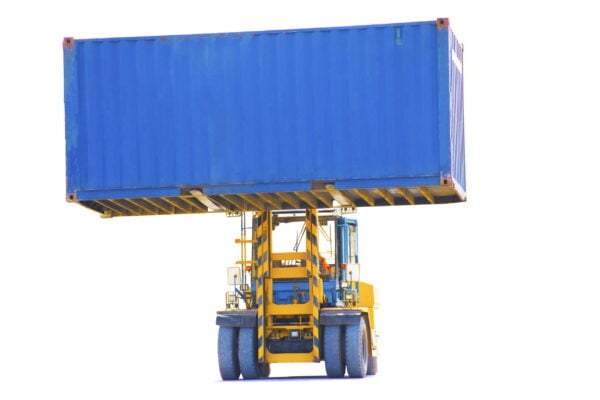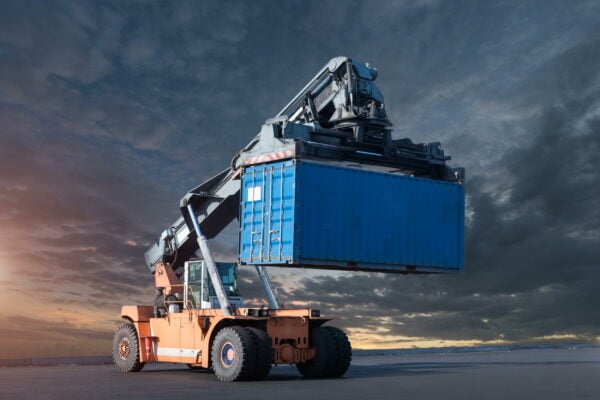Shipping containers are usually lifted or moved by one of six vehicles:
- Empty container handler
- Loaded container handler (a heavier version of the empty container handler)
- Reach stacker
- Crane
- Straddle carrier
- Sideloader
- Forklift
The first five usually lift from the top corner castings of the container (or sometimes the side). A side loader lifts using chains from the bottom corner casting. A forklift uses fork pockets at the bottom of the container.

Forklifts provide a lot of flexibility when lifting containers as they are manoeuvrable, multi-purpose, and relatively easy to drive. They can load a container much quicker than, for example, a boom crane, because the forklift operator simply slides the forks into the fork pockets and picks it up. With a crane, someone has to manually connect the chains to the corner castings. However, a crane is better for precise placement.
Standard warehouse forklifts should never be used to move a shipping container as they are not set up to do it safely. The tines on a container forklift should be at least 1.8m long so that they extend well past the load centre.
Considerations for lifting containers
Weight
A large shipping container can be 30 tonnes full and 2.2 tonnes empty, while a small shipping container is just under half that. This means that the forklift has to be large. The counterbalance has to offset the weight of the container.
Dimensions
The dimensions of a standard ISO shipping container are 2.43m wide, 2.59m high and come in two lengths: 6.06m and 12.2m.
Due to its width being 2.43m, that means the load centre (assuming it’s evenly loaded and against the backrest) is 1.215m (i.e. double that of a standard pallet). This means that longer forks are required, but also that there is much more leverage fighting against the counterbalance.
The height means that the shipping container is more likely to obscure the view of the driver when driving forwards.
The width means that if the load is unbalanced to one end of the container, the forklift can be easily tipped sideways because of the torsional forces. This is especially risky if one wheel drops into a pothole, or if the forklift turns too quickly. Forklifts that lift containers should be as wide as possible with dual wheels at the front.
Lifting height
Containers are usually stacked on top of one another.
Typical stacking heights per machine (this will vary per machine and container weight):
- Container handlers are capable of stacking containers up to 7 high
- Reach stackers are capable of stacking containers up to 5 high
- Cranes can stack containers up to 9 high
- Straddle carriers can stack containers up to 4 high.
- Side loaders can only usually lift off the ground and onto a truck.
- Forklifts can stack containers up to 5 high.
Training and operational considerations
Operators should have a forklift operator’s certificate plus additional training in safe stacking and manoeuvring with a wide load.
Given the size and weight of containers, it’s especially important to not drive with a raised load.
Because the forklift operator doesn’t know the weight distribution of the container, care must be taken when lifting, otherwise the forklift could become unbalanced and tip sideways.
When purchasing a forklift for moving containers, don’t under-spec the forklift otherwise it will cost more in maintenance because the forklift will struggle to lift the load. The forklift should have fork positions that match the shipping container fork pockets.
Check that the rated capacity of the forklift is stated for lifting containers with a load centre of 1.2m. If they quote 600mm, then the figure will not be accurate for a container; it could be as little as half of the stated capacity at 600mm when lifting a container.
If a forklift driver also is required to drive other machines, such as a reach stacker, a different qualification might be required, such as a wheels endorsement.

Safety considerations
Companies should consider the impact of strong winds on containers as they are being carried.
Uneven surfaces can have a great effect than expected on the stability of the forklift because of the width of the load.
Containers create a large blind spot. Pedestrians and other vehicle traffic need to be well separated from forklift traffic.
Companies should ensure that the surface used to pick up and manoeuvre containers using a forklift is capable of taking the weight of the forklift plus the container – this could exceed 75000kg (30,000kg for the container and 45,000kg for the forklift).

